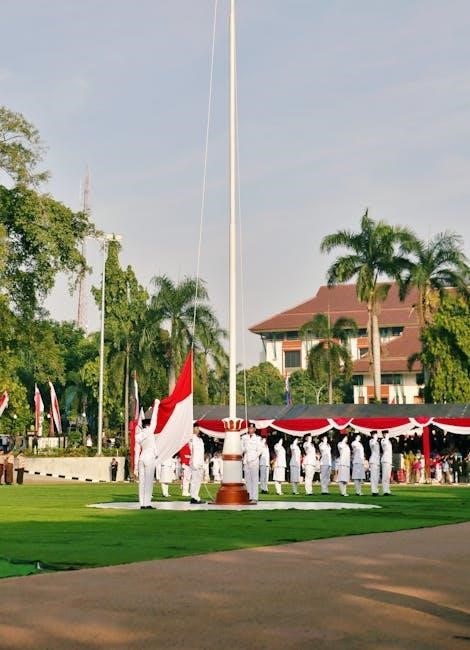
military alphabet pdf
The military alphabet, also known as the NATO Phonetic Alphabet, is a standardized system used to clearly communicate letters and numbers․ It ensures accuracy in radio and phone communications by assigning unique words to each letter, reducing errors․ Widely adopted by military, aviation, and maritime organizations, it promotes universal understanding․ The PDF versions of this alphabet are easily accessible online, making it a valuable tool for training and professional use․
What is the Military Alphabet?
The military alphabet, also known as the NATO Phonetic Alphabet, is a standardized system of communication․ It assigns unique code words to each letter and number to ensure clarity in radio, phone, and other oral communications․ This system is essential for avoiding misunderstandings, especially in environments where standard letter pronunciation might be unclear․ Each letter, such as “Alpha” for A or “Bravo” for B, is represented by a distinct word․ This method is widely used by military, aviation, and maritime organizations to maintain precision․ The availability of the military alphabet in PDF formats allows individuals to download, print, and easily reference the chart for training or professional use․
Importance of the Military Alphabet
The military alphabet is crucial for clear and accurate communication, particularly in high-stakes environments․ It eliminates confusion caused by similar-sounding letters, ensuring precise transmission of information․ This is vital for military operations, aviation, and maritime communications, where errors can have serious consequences․ The universal adoption of the NATO Phonetic Alphabet allows for seamless communication across different languages and regions․ Its standardized nature ensures consistency, reducing the risk of misinterpretation․ Additionally, the availability of the military alphabet in PDF formats makes it easily accessible for training, enabling individuals to learn and use the system effectively․ This widespread use underscores its importance as a tool for professional and emergency communications․
Structure of the Military Alphabet
The military alphabet is structured as a phonetic spelling system, assigning distinct words to each letter and number․ Each letter from A to Z is paired with a unique code word, such as Alpha for A and Bravo for B․ This system ensures clarity in communication, especially over radio or phone․ The structure includes 26 letters, each with a corresponding phonetic word, and extends to numbers, which are also spoken clearly to avoid confusion․ The PDF versions of the military alphabet typically include tables or charts that list each letter, its phonetic equivalent, and sometimes Morse code and semaphore symbols․ This organized format makes it easy to reference and learn, providing a standardized tool for consistent communication across various industries and languages․

History and Development

The military alphabet originated from early phonetic systems used in World War I and II․ NATO standardized it in 1956 for global communication efficiency․
Early Phonetic Alphabets
The early phonetic alphabets were developed during World Wars I and II to improve communication clarity in military and aviation contexts․ These systems used simple, distinct words for each letter to avoid confusion over radio transmissions․ For example, “A” might be “Able” and “B” as “Baker․” These early systems varied between countries and organizations, leading to inconsistencies․ The need for a universal standard became evident, prompting further development and eventual standardization by NATO in 1956․ These early alphabets laid the foundation for the modern military alphabet used today, ensuring clear and effective communication across languages and regions․
NATO’s Role in Standardization
NATO played a pivotal role in standardizing the phonetic alphabet in 1956, addressing the need for a universal system across member nations․ By unifying diverse earlier versions, NATO ensured consistent communication in military and aviation operations․ The standardized alphabet assigns specific code words to each letter, such as “Alpha” for “A” and “Bravo” for “B,” minimizing errors; This system’s adoption by NATO facilitated clear communication globally, enhancing collaboration among allies․ The PDF versions of this standardized alphabet are widely available for training and operational use, reflecting NATO’s commitment to efficiency and clarity in international operations․
Evolution Over Time
The military alphabet has undergone significant evolution since its inception․ Initially developed during World War I, early phonetic alphabets varied by region and organization, leading to communication challenges․ Post-WWII, the International Civil Aviation Organization (ICAO) introduced a standardized system, which NATO later refined in 1956․ This version replaced earlier inconsistencies, establishing a global standard for clear communication․ Over the years, minor adjustments have been made to enhance clarity, such as changing “Union” to “Uniform․” The availability of PDF charts and digital tools has further facilitated its adoption and accessibility, ensuring continued relevance in modern military and professional settings․ This evolution reflects the ongoing need for precise communication in critical operations․
How the Military Alphabet Works
The military alphabet replaces each letter with a unique word to ensure clear communication․ For example, “A” becomes “Alpha” and “B” becomes “Bravo․” This system minimizes errors during radio transmissions by avoiding letter confusion․ Available as a PDF, it’s a handy reference for training and daily use, providing a standardized tool for precise communication in various professional settings․
Purpose of the Phonetic Alphabet

The phonetic alphabet is designed to ensure clear and precise communication, especially in environments where standard letter pronunciation might be unclear․ By assigning unique words to each letter, it eliminates confusion and errors in transmission․ For example, “A” becomes “Alpha,” and “B” becomes “Bravo․” This system is crucial for military, aviation, and maritime operations, where miscommunication could lead to serious consequences․ The phonetic alphabet also facilitates universal understanding, transcending language barriers․ Its standardized nature makes it an essential tool for training and professional use, ensuring that messages are conveyed accurately and efficiently․
Available in PDF formats, the phonetic alphabet serves as a quick reference guide, making it accessible for learning and practical application across various industries․
Structure and Organization
The military alphabet, also known as the NATO Phonetic Alphabet, is structured to provide clear and unambiguous communication․ It consists of 26 code words, each corresponding to a letter of the English alphabet, from “Alpha” for A to “Zulu” for Z․ This system ensures that letters are easily distinguishable, even in noisy or low-quality communication environments․ The alphabet is typically presented in a table or chart format, making it easy to reference and learn․ Many PDF versions include additional features, such as phonetic pronunciations and numerical codes, to enhance usability․ The standardized structure allows for universal application across languages and industries, ensuring consistency and accuracy in communication․
This organized approach makes the military alphabet a reliable tool for professional and training purposes․
Key Features for Clear Communication
The military alphabet is designed with specific features to ensure clarity in communication․ Each letter is assigned a unique code word, such as “Alpha” for A and “Bravo” for B, to eliminate confusion․ The system includes standardized pronunciations, making it universally understandable, even across different languages․ This phonetic clarity minimizes errors in transmission, particularly in noisy environments․ Additionally, the alphabet often includes numerical codes, further enhancing accuracy․ Many PDF versions of the military alphabet include visual aids, such as charts or tables, to facilitate quick reference․ These features collectively ensure that the military alphabet remains a reliable tool for clear and efficient communication in professional and high-stakes settings․

Applications of the Military Alphabet
The military alphabet is widely used in military operations, aviation, maritime communications, law enforcement, emergency services, and civilian sectors for clear and precise communication․ Its universal application ensures accuracy․
Military Communications
The military alphabet is indispensable in military communications, ensuring clarity and precision in high-stakes environments․ It replaces ambiguous letter sounds with distinct words, minimizing errors during radio transmissions․ Used globally by armed forces, it standardizes communication across languages and accents․ The NATO Phonetic Alphabet, as detailed in the PDF, assigns codes like “Bravo” for B and “Charlie” for C, preventing misunderstandings․ This system is critical for tactical operations, navigation, and coordination, where clear communication can be a matter of life and death․ Its structured format, available in downloadable PDFs, is a cornerstone of military training and operations worldwide․
Aviation and Air Traffic Control
In aviation and air traffic control, the military alphabet is essential for clear and precise communication․ Pilots and controllers use it to avoid confusion when transmitting critical information like aircraft IDs, runway designations, and weather updates․ For example, “Foxtrot” for F and “Sierra” for S ensure clarity over radio․ The PDF charts available online provide a quick reference, aiding in rapid identification of letters and numbers․ This standardized system is mandated by international aviation organizations, ensuring consistency worldwide․ By eliminating ambiguity, it enhances safety and efficiency in air operations, making it a vital tool for all aviation professionals․ Its universal adoption ensures seamless communication across different languages and regions․
Maritime Communications
The military alphabet plays a crucial role in maritime communications, where clear transmission of information is vital for safety and navigation․ Ship crews and coastal stations use phonetic words to prevent misunderstandings, especially in noisy environments․ For instance, “Bravo” for B and “Zulu” for Z ensure precise communication of vessel names, coordinates, and weather alerts․ PDF charts of the NATO Phonetic Alphabet are widely used by sailors and officers for quick reference, aiding in efficient data exchange․ This standardized system is endorsed by international maritime organizations, fostering clarity across different regions and languages․ By minimizing errors in transmission, it directly contributes to safer navigation and operational efficiency at sea․
Law Enforcement and Emergency Services
The military alphabet is widely utilized by law enforcement and emergency services to ensure clear and precise communication․ Police and firefighters often rely on phonetic codes to avoid misunderstandings during high-stress situations․ For example, “Bravo” for B and “Adam” for A are commonly used to clarify names, locations, and operational codes․ This system is particularly useful in noisy environments or when coordinating large-scale operations․ Many agencies distribute NATO Phonetic Alphabet PDF charts for training purposes, ensuring officers can quickly reference and communicate accurately․ This standardized approach enhances teamwork and response efficiency, making it an essential tool in public safety․ Its universal adoption across agencies fosters seamless coordination during joint operations and emergencies․
Business and Civilian Use
The military alphabet has found practical applications in various civilian and business contexts, particularly where clear communication is essential․ Companies often use phonetic codes to avoid confusion in customer service, technical support, and international operations․ For instance, travel agencies and call centers employ this system to clarify names, destinations, or complex terms․ The NATO Phonetic Alphabet PDF is a popular resource for businesses, providing a standardized tool for training employees․ It enhances professionalism and efficiency in communication, especially in noisy environments or multilingual settings․ Additionally, some brands and products incorporate phonetic names to ensure global recognition and clarity․ This universal system bridges language barriers, making it invaluable for modern business operations and customer interactions worldwide․

Education and Training
The military alphabet plays a significant role in education and training programs, particularly in fields requiring clear communication․ Schools and training institutions often teach the NATO Phonetic Alphabet to students learning about aviation, maritime, or emergency services․ The PDF versions of the alphabet are widely used as study aids, providing a clear and standardized reference for learners․ Many educational resources include interactive charts and exercises to help students memorize the phonetic codes․ This system is also integrated into language and communication courses to improve pronunciation and reduce errors․ Additionally, professional training programs use the military alphabet to simulate real-world scenarios, ensuring trainees are proficient in its use before entering high-stakes environments․ Its universality makes it an ideal tool for diverse learning environments․

Downloading and Using the Military Alphabet PDF
The military alphabet PDF is easily downloadable from NATO’s official website and other reliable sources․ It is free, high-quality, and available in various formats for printing and sharing, ideal for educational and professional use․
Where to Find the PDF
The military alphabet PDF can be found on official NATO websites, such as NATO’s declassified resources and NATO’s alphabet section․ Additionally, it is available on educational and military training websites․ Many government and aviation-related portals offer free downloads․ Some popular sources include Veteran․com and other official military training platforms․ These PDFs are often provided in high-quality formats suitable for printing and sharing․ They are easily accessible, ensuring widespread availability for both professional and civilian use․
How to Download the PDF
To download the military alphabet PDF, visit the official NATO website or other reputable sources like Veteran․com․ Navigate to the resources or downloads section․ Locate the NATO Phonetic Alphabet PDF link and click to open it․ Depending on your browser settings, the PDF may open directly or prompt a download․ Right-click the document and select “Save As” to download it to your device․ Ensure the file format is PDF for compatibility․ Once downloaded, you can print or share it easily․ This process ensures quick and efficient access to the standardized military alphabet for professional or personal use․

Printing and Sharing the PDF
Once downloaded, the military alphabet PDF can be easily printed on standard A4 paper․ Open the PDF using a viewer like Adobe Acrobat and select the print option․ Ensure the print settings are set to “Actual Size” to maintain clarity; The document is designed in high quality for clear readability․ For sharing, attach the PDF to an email or upload it to a cloud storage service․ You can also share it via instant messaging platforms․ Printing multiple copies is ideal for training sessions or team use․ The PDF’s professional layout makes it suitable for both personal and professional environments, ensuring effective communication and learning․

Benefits of Using the Military Alphabet
The military alphabet enhances communication clarity, reducing errors in transmission․ It offers universal understanding across languages and professions, making it indispensable for military, aviation, and emergency services․ Its standardized structure ensures precision and efficiency, fostering clear and accurate exchanges, especially in high-stakes environments where miscommunication can be critical․
Improved Communication Clarity
The military alphabet significantly enhances communication clarity by eliminating ambiguity in spoken words․ Each letter is assigned a unique and distinct word, ensuring that messages are conveyed accurately, even in noisy or low-quality transmission environments․ For example, letters like “B” and “P,” which sound similar, are represented by “Bravo” and “Papa,” respectively, minimizing confusion․ This system is particularly crucial in high-stakes fields such as aviation, maritime, and military operations, where clear communication can be a matter of life and death․ By standardizing the pronunciation of each letter, the military alphabet ensures that all parties involved in a conversation understand the message without room for misinterpretation․
Universality Across Languages
The military alphabet’s universality across languages is one of its most significant advantages․ By using standardized words for each letter, it transcends language barriers, ensuring clear communication among individuals from diverse linguistic backgrounds․ This is particularly vital in international operations, such as NATO missions or global aviation, where participants may speak different languages․ For example, “Alpha” for “A” and “Bravo” for “B” are universally recognized, eliminating potential misunderstandings․ This system fosters seamless interaction, whether in military, maritime, or emergency response contexts․ Its global adoption highlights its effectiveness in breaking down communication silos created by language differences, making it an indispensable tool for international collaboration and coordination․
Reduction of Errors in Transmission

The military alphabet significantly reduces errors in transmission by replacing letters with distinct, universally recognized words․ This system minimizes misunderstandings that often occur when letters sound similar, such as “B” and “C․” By using clear, unique words like “Bravo” for “B” and “Charlie” for “C,” it ensures that messages are conveyed accurately, even in noisy or high-stress environments․ This precision is critical in military, aviation, and emergency communications, where errors can have serious consequences․ The structured approach of the military alphabet acts as a safeguard, making it easier for recipients to interpret information correctly․ Its effectiveness in reducing transmission errors has made it a cornerstone of professional communication systems worldwide․
Enhanced Professional Training
The military alphabet plays a pivotal role in enhancing professional training across various industries․ By standardizing communication, it ensures consistency in teaching and learning environments․ Trainees can quickly reference the PDF chart to memorize the phonetic codes, accelerating their mastery of the system․ This tool is particularly valuable in military, aviation, and emergency services training, where clear and precise communication is essential․ The PDF format allows for easy distribution and accessibility, making it a practical resource for instructors and learners alike․ Its use in training programs helps build proficiency, ensuring that professionals can communicate effectively in high-stakes situations․ This standardized approach fosters a common language, improving overall performance and readiness․